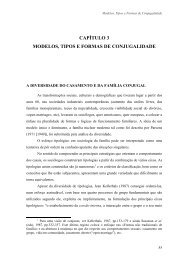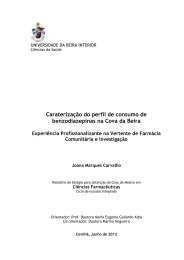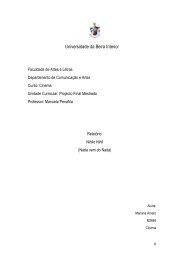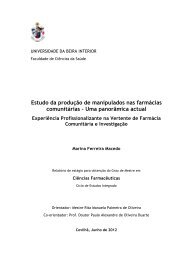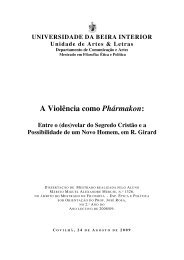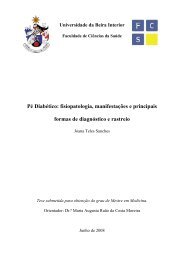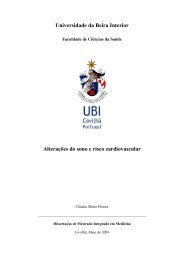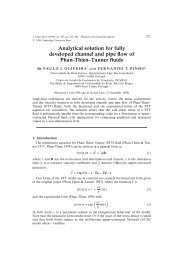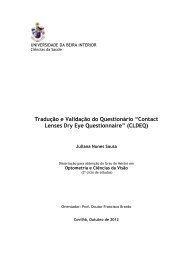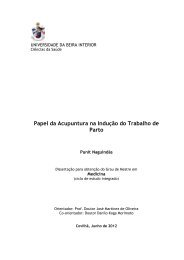Tese_Tânia Vieira.pdf - Ubi Thesis
Tese_Tânia Vieira.pdf - Ubi Thesis
Tese_Tânia Vieira.pdf - Ubi Thesis
Create successful ePaper yourself
Turn your PDF publications into a flip-book with our unique Google optimized e-Paper software.
Chapter I - Introduction<br />
Implant-associated infections are the result of bacteria adhesion to an implant surface and<br />
subsequent biofilm formation at the implantation site (Jones et al. 2008; Simchi et al. 2011).<br />
Biofilms are communities of microbial cells that attach to a surface and secrete a hydrated<br />
extracellular polymeric matrix (Gurjala et al. 2011). The organisms become embedded in this<br />
matrix, which is composed of polysaccharides, proteins, glycoproteins, glycolipids, and<br />
extracellular deoxyribonucleic acid (DNA) (Gurjala et al. 2011). The matrix polymers support<br />
microcolonies of cells, allows cell–cell communication, forms water channels, retains and<br />
concentrates nutrients, and can support gene transfer through conjugation, transformation, and<br />
transduction (Edwards et al. 2004; Martin et al. 2009). The matrix is thereby responsible for the<br />
maintenance of the structural integrity of the biofilm and provide an ideal matrix for bacterial<br />
cell growth (Monteiro et al. 2009). The biofilm formation is described as a sequence of different<br />
steps. In the first one, microbial cells adhere to the biomaterial surface, through<br />
exopolysaccharides that are synthesized by the bacteria (Speranza et al. 2004; Kalishwaralal et<br />
al. 2010). Surface adhesion is a critical step in the pathogenesis of implant-related infections<br />
and represents the beginning of the colonization of biomaterial surfaces (Montanaro et al. 2011).<br />
Thereafter, it follows the accumulation in multiple cell layers, biofilm maturation, and<br />
detachment of cells from the biofilm into a planktonic state to initiate a new cycle of biofilm<br />
formation elsewhere (Speranza et al. 2004; Montanaro et al. 2011).<br />
The biofilm allows microbes to survive to host immune defenses and systemic antibiotic<br />
therapies (Campoccia et al. 2010), which is the main reason for the high prevalence of infections<br />
(Fernebro 2011). Therefore, extraordinary antibiotic resistance is a general feature of biofilm<br />
which is caused by several factors (Simchi et al. 2011). These factors include the compact nature<br />
of biofilm structures, the presumed reduced rates of cellular growth and cellular respiration of<br />
the bacteria in the biofilm and the protection conferred by biofilm matrix polymers (Simchi et<br />
al. 2011). The antibiotic resistance of biofilms is also related to the fact that in the extracellular<br />
polymeric substance cells are allowed to change their proteome (up to 50% of the proteome may<br />
differ from the same microorganism in a planktonic state) to their existence in a sessile state<br />
(Nava-Ortiz et al. 2010). This state has low metabolic levels and downregulated cell activity,<br />
which leads a decreased antimicrobial susceptibility compared with planktonic cells (Nava-Ortiz<br />
et al. 2010). Furthermore, the alteration of the proteome makes that bacteria in a biofilm<br />
express different sets of genes than those that are expressed in its planktonic form (Martin et al.<br />
2009). This have important implications for clinical therapeutics, since the antimicrobials does<br />
not reach the bacterial cells in the biofilm (Martin et al. 2009). Thus, in the biofilm, after<br />
bacteria colonization, the resistance to antimicrobial agents is dramatically increased (up to<br />
1000-fold) and even the antimicrobial agents that are effective against planktonic cells are<br />
ineffective against the same bacteria growing in a biofilm (Jones et al. 2008; Martin et al. 2009;<br />
Monteiro et al. 2009; Simchi et al. 2011). Thereby, biofilm leads to an undesirable and<br />
deteriorative impact to several fields, such as in medicine, industry, and commercial products<br />
(Inphonlek et al. 2010).<br />
4




